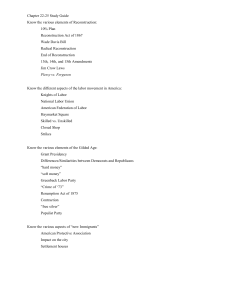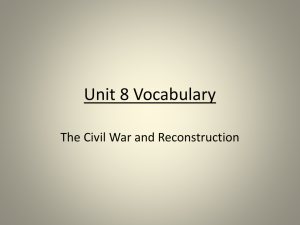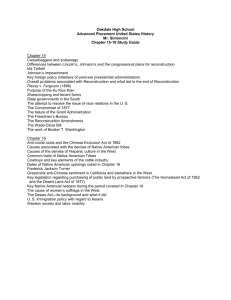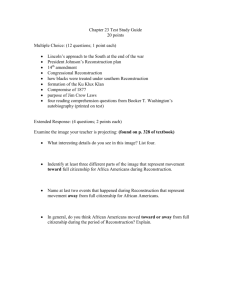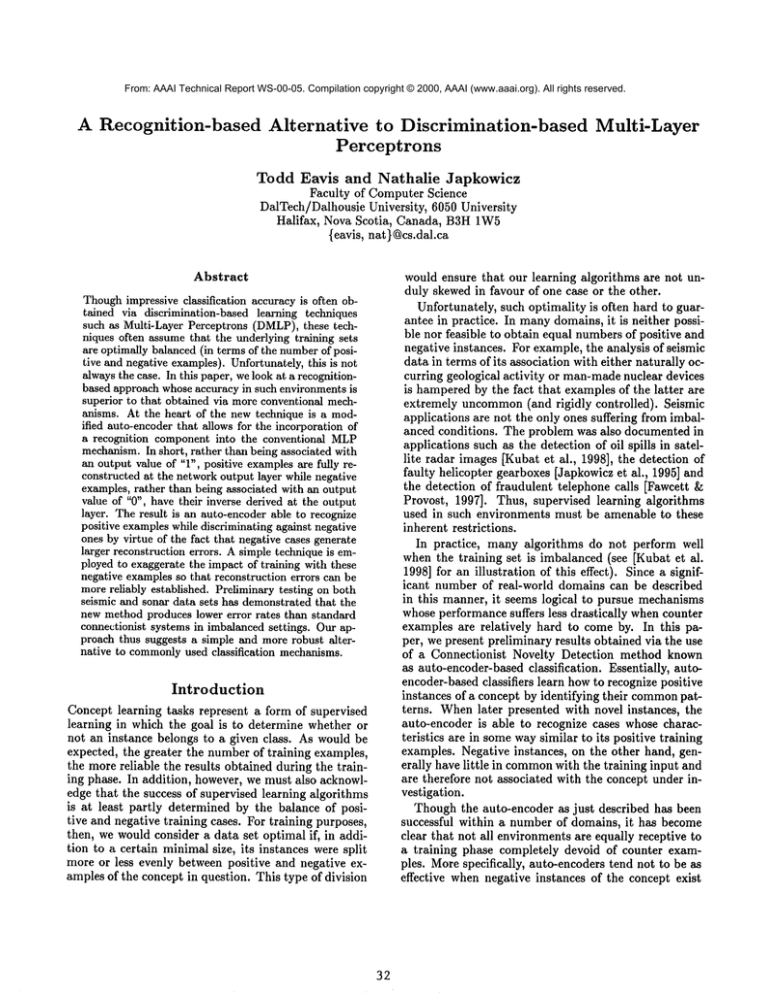
From: AAAI Technical Report WS-00-05. Compilation copyright © 2000, AAAI (www.aaai.org). All rights reserved.
A Recognition-based
Alternative
to Discrimination-based
Perceptrons
Multi-Layer
Todd Eavis and Nathalie Japkowicz
Faculty of Computer Science
DalTech/Dalhousie University, 6050 University
Halifax, Nova Scotia, Canada, B3H1W5
{eavis, nat}@cs.dal.ca
would ensure that our learning algorithms are not unduly skewedin favour of one case or the other.
Unfortunately, such optimality is often hard to guarantee in practice. In manydomains, it is neither possible nor feasible to obtain equal numbers of positive and
negative instances. For example, the analysis of seismic
data in terms of its association with either naturally occurring geological activity or man-madenuclear devices
is hamperedby the fact that examples of the latter are
extremely uncommon(and rigidly controlled). Seismic
applications are not the only ones suffering from imbalanced conditions. The problem was also documented in
applications such as the detection of oil spills in satellite radar images [Kubat et al., 1998], the detection of
faulty helicopter gearboxes [Japkowicz et al., 1995] and
the detection of fraudulent telephone calls [Fawcett &
Provost, 1997]. Thus, supervised learning algorithms
used in such environments must be amenable to these
inherent restrictions.
In practice, many algorithms do not perform well
when the training set is imbalanced (see [Kubat et al.
1998] for an illustration of this effect). Since a significant number of real-world domains can be described
in this manner, it seems logical to pursue mechanisms
whose performance suffers less drastically when counter
examples are relatively hard to come by. In this paper, we present preliminary results obtained via the use
of a Connectionist Novelty Detection method known
as auto-encoder-based classification. Essentially, autoencoder-based classifiers learn howto recognize positive
instances of a concept by identifying their commonpatterns. Whenlater presented with novel instances, the
auto-encoder is able to recognize cases whose characteristics are in someway similar to its positive training
examples. Negative instances, on the other hand, generally have little in commonwith the training input and
are therefore not associated with the concept under investigation.
Though the auto-encoder as just described has been
successful within a number of domains, it has become
clear that not all environments are equally receptive to
a training phase completely devoid of counter examples. More specifically, auto-encoders tend not to be as
effective when negative instances of the concept exist
Abstract
Thoughimpressive classification accuracy is often obtained via discrimination-based learning techniques
such as Multi-Layer Perceptrons (DMLP),these techniques often assumethat the underlying training sets
are optimally balanced(in terms of the numberof positive and negative examples).Unfortunately, this is not
alwaysthe case. In this paper, welook at a recognitionbased approach whoseaccuracy in such environmentsis
superior to that obtained via moreconventional mechanisms. At the heart of the new technique is a modified auto-encoder that allows for the incorporation of
a recognition component into the conventional MLP
mechanism.In short, rather than being associated with
an output value of "1", positive examplesare fully reconstructed at the networkoutput layer while negative
examples, rather than being associated with an output
value of "0", have their inverse derived at the output
layer. The result is an auto-encoder able to recognize
positive exampleswhile discriminating against negative
ones by virtue of the fact that negative cases generate
larger reconstruction errors. A simple technique is employed to exaggerate the impact of training with these
negative examplesso that reconstruction errors can be
morereliably established. Preliminary testing on both
seismic and sonar data sets has demonstratedthat the
new methodproduces lower error rates than standard
connectionist systems in imbalancedsettings. Our approach thus suggests a simple and more robust alternative to commonly
used classification mechanisms.
Introduction
Concept learning tasks represent a form of supervised
learning in which the goal is to determine whether or
not an instance belongs to a given class. As would be
expected, the greater the number of training examples,
the more reliable the results obtained during the training phase. In addition, however, we must also acknowledge that the success of supervised learning algorithms
is at least partly determined by the balance of positive and negative training cases. For training purposes,
then, we would consider a data set optimal if, in addition to a certain minimal size, its instances were split
more or less evenly between positive and negative examples of the concept in question. This type of division
32
as a subset of the larger positive set. In such cases,
the network is likely to confuse counter examples with
the original training cases since it has had no opportunity to learn those patterns which can serve to delineate the two. Consequently, the method presented here
will incorporate a local discrimination phase within the
general recognition-based framework. The result is a
network that can successfully classify mixed instances
of the concept, despite having been given a decidedly
imbalanced training set.
Previous
Work
Although the imbalanced data set problem is starting
to attract the attention of a numberof researchers, attempts at addressing it have remained uncoordinated.
Nevertheless, these research efforts can be organized
into four categories
¯ Methods in which the class represented by a small
data set gets over-sampled so as to match the size of
the opposing class.
¯ Methods in which the class represented by the large
data set can be down-sized so as to match the size of
the other class.
¯ Methods that internally bias the discriminationbased process so as to compensate for the class imbalance.
¯ Methods that ignore (or makes little use of) one
the two small classes altogether.
The first method was used by [Ling &5 Li, 1998]. It
simply consists of augmenting the small data set by
re-sampling the instance multiple times. Other related schemes could diversify the augmented class by
injecting some noise into the repeated patterns. The
second method was investigated in [Kubat & Matwin,
1997] and consists of removing instances from the wellrepresented class until it matchesthe size of the smaller
class. The challenge of this approach is to remove instances that do not provide essential information to the
classification process. The third approach was studied
by [Pazzani et al., 1994] whoassigns different weights
to examplesof the different classes, [Fawcett &Provost,
1997] whoremoverules likely to over-fit the imbalanced
data set, and [Ezawa et al., 1996] who bias the classifter in favour of certain attribute relationships. Finally, the fourth method was studied in its extreme
form (i.e., in a form that completely ignores one of
the classes during the concept-learning phase) by [Japkowicz et al., 1995]. This method consisted of using
a recognition-based rather than a discrimination-based
inductive scheme. Less extreme implementations were
studied by [Riddle et al., 1994] and [Kubat et al., 1998]
who also employ a recognition-based approach but use
some counter-examples to bias the recognition process.
Our current study investigates a technique that falls
along the line of the work of [Riddle et al., 1994] and
[Kubat et al., 1998] and extends the auto-encoder approach of [Japkowicz et al., 1995] by allowing it to
consider counter examples. The method, however, differs from [Riddle et al., 1994] and [Kubat et al., 1998]
in its use of the connectionist rather than rule-based
paradigm.
Our method is also related to previous work in the
connectionist community. In the past, auto-encoders
have typically been used for data compression [e.g., Cottrell et al., 1987]. Nevertheless, their use in classification tasks has recently been investigated by [Japkowicz
et al., 1995], [Schwenk~ Milgram, 1995], [Gluck &Myers, 1993] and [Stainvas et al., 1999]. [Japkowiczet al.,
1995] and [Schwenk&5 Milgram, 1995] use it in similar
ways. As mentioned previously, [Japkowicz et al., 1995]
use the auto-encoder to recognize data of one class and
reject data of the other class. [Schwenk & Milgram,
1995], on the other hand, use it on multi-class problems
by training one auto-encoder per class and assigning
a test example to the class corresponding to the autoencoder which recognized it best. Both [Gluck & Myers,
1993] and [Stainvas et al., 1999] use the auto-encoder
in conjunction with a regular discrimination-based network. They let their multi-task learner simultaneously
learn a clustering of the full training set (including conceptual and counter-conceptual data) and discriminate
between the two classes. The discrimination step acts
as both a labelling step (in which the clusters uncovered
by the auto-encoder get labelled as conceptual or not)
and a fine-tuning step (in which the class information
helps refine the auto-encoder clustering). Our method
is similar to [Gluck &5Myers, 1993] and [Stainvas et al.,
1999] in that it too uses class information about the two
classes and lets this information act both as a labelling
and a fine-tuning step. However,it differs in that the
auto-encoder is used in a different way for each class.
Implementation
Auto-encoder. As stated, an auto-encoder learns by
determining the patterns commonto a set of positive
examples(in the standard case). It then uses this information to generalize to examplesit has not seen before.
In terms of the training itself, the key componentis a
supervised learning phase in which input samples (in
the form of a multi-featured vector) are associated with
an appropriate target vector. The target, in fact, is
simply a duplicate of the input itself. In other words,
the network is trained so as to reproduce the input at
the output layer. This, of course, stands in contrast to
the conventional neural network concept learner which
is trained to associate positive instances with a target
value of "1" and negative examples with a "0". The
architectures of the auto-encoder (with 6 input/output
units and 3 hidden units) versus that of the conventional neural network (with 6 input units, 3 hidden
units and 1 output unit) are illustrated in Figure 1.
Once an auto-encoder has been trained, it is necessary to provide a means by which new examples can be
accurately classified. Since we no longer have a simple
binary output upon which to make the prediction, we
must turn to what is called the "reconstruction error".
i
(a)
DMLP
2 ......
(b)
RMLP
Figure 1: Examples of Feedforward Neural Networks:
(a)discrimination-based
DMLP;(b) recognition-based
RMLP
The reconstruction error is defined as
k
2- o(i)]
(1)
i=1
where I(i) and O(i) are the corresponding input
output nodes at position i and k represents the number
of features in the vector. In other words, we ascertain
the degree to which the output vector -- as determined
by the trained network -- matches the individual values
of the original input. Of course, in order to apply the
reconstruction error concept, we must establish some
constraint on the allowable error for instances that will
be deemed to be positive examples of the given concept. To do so, we include a threshold determination
component in the training phase. Since we would like
the threshold T to be closely associated with the mean
of the full set R of individual reconstruction errors, we
define the threshold as follows
T = mean(R) + Z(std(R))
(2)
We use the Z parameter as a means of controlling
the range of acceptable reconstruction error valUes. In
essence, it represents the desired confidence interval for
the mean reconstruction error and, as such, corresponds
to the standard Z value commonlyused in statistical
analysis. By combining the Z value with the mean and
standard deviation of the error distribution,
we may
efficiently tune our boundary to suit the input at hand.
Extended auto-encoder.
In the current study the
auto-encoder has been extended to allow for what we
call local discrimination. In other words, a small number of negative examples are included in the training
set so that the network has the opportunity to determine those features that differentiate clusters of negative instances from the larger set of positive instances.
In cases where there is considerable overlap between
concept and non-concept instances, it is expected that
this additional step maysignificantly lower classification error. The extension to the new model is relatively
straight-forward. As before, target values for positive
input are represented as a duplication of the input vectors. In contrast, however, the target vector for nega-
tive instances is constructed as an inversion of the input. For example, the three-tuple <0.5, 0.6, 0.2> would
become <-0.5, -0.6, -0.2> at the output layer. During
the threshold determination phase, the network output
vectors for these negative examplesare assessed relative
to the vectors that would have been expected had the
input actually been a positive example. In other words,
the negative reconstruction error is the "distance" between the inverted output and the original input.
Armedwith this new information, we are now able
to establish both positive and negative reconstruction
error ranges. A definitive classification boundaryis determined by finding the specific point that offers the
minimal amount of overlap. Though this might at first
appear to be a trivial task, in practice it is somewhat
more complicated than expected. Typically, due to the
underlying data imbalance, the range of positive reconstruction errors is muchmore tightly defined than the
range of negative errors (i.e., more compactly clustered
around the mean). For this reason, it is necessary to
skew the boundary towards the mean of the positive
reconstruction error. In our study, this extra step was
not required since we employeda "target shifting" technique (see below) that significantly reduced the likelihood of boundary overlap. As a result, we were simply able to utilize the positive reconstruction boundary
as described in the preceding section. Once the final
boundary condition has been established, classification
of novel examples is relatively simple. Instances are
passed to the trained network and reconstruction errors calculated. Errors below the boundary are associated with positive examples of the concept, while those
above signify non-concept input.
Target Shifting. In theory, the local discrimination
technique as just described should produce distinctive
error patterns for both positive and negative training input. Unfortunately, initial testing using this basic scheme was quite disappointing. In particular, it
proved almost impossible to produce non-overlapping
error ranges. An analysis of the raw network output
showed that the auto-encoder was indeed inverting the
negative training cases. However,it was clear that the
negative reconstruction was simply much smaller than
expected. The problem was two-fold. First, the inclusion of empty or zeroed feature values effectively reduced the number of vector elements that could contribute to the reconstruction error. For example, if
a domain provides twenty distinctive features for each
instance, but individual cases rarely have more than
five or six non-zero feature values, then the ability of
the network to produce distinguishable error ranges is
severely curtailed. Second, and perhaps more importantly, the normalization of input prior to training can
have a deleterious effect upon threshold determination.
In particular, the existence of out-liers in the original
input set has a tendency to squash many feature values downtowards zero. If these near-zero features belong to negative training examples, then the inverted
features will be deceptively close to the non-inverted
input, l?or example, a normalized input value of 0.001
would become -0.001 in a perfectly trained network.
Consequently, it is likely that the reconstruction error
for manynegative training cases will be no greater than
their positive counterparts.
To combat this problem, it was necessary to utilize
some mechanismthat could exaggerate the error associated with negative examples while leaving the positive
reconstruction error unchanged. Wechose to employ a
simple technique by which the entire normalized range
of input values was shifted in order to create target
output. Positive instances are modified simply by incrementing each element of the input vector by one.
Negative input is also incremented but, in this case,
the sign of each element is also inverted. For example, the positive input vector <0.2, 0.3, 0.4> becomes
<1.2, 1.3, 1.4> while the negative vector <0.2, 0.5, 0.9>
becomes <-1.2, -1.5, -1.9>. This approach to target vector generation has two fundamental advantages.
First, it maintains the normalized input patterns so
that features with large absolute values do not dominate the training phase. Second, and more significantly
in the current context, we can ensure that properly recognized negative instances will result in the generation
of significantly exaggerated reconstruction errors. Typically, negative instances produce values greater than
two for each component of the vector while positive
instances contribute errors of less than one per component. (Note: Wesay "typically" since the network is
unlikely to perfectly transform all features into the expected ranges). In the initial implementation, only nonzero vector elements were actually inverted, the belief
being that transforming these "empty" features might
hamper the network’s ability to properly recognize the
original input. However,in practice, the primary result
of not shifting the zero values was to distribute more
evenly target output and, in the process, to bring positive and negative boundaries much closer together. As
a result, all values were inverted in subsequent experiments.
Target shifting has proven to be a simple but effective technique for establishing appropriate reconstruction error constraints. As should be obvious, domains
exhibiting a higher number of features generally produce more striking differences between positive and negative boundaries. Nevertheless, even for feature-poor
domains, it is generally quite easy to define the appropriate ranges.
range motivation for this application is to create reliable
tools for the automatic detection of nuclear explosions
throughout the world 1 in an attempt to monitor the
Comprehensive Test Ban Treaty. This discrimination
problem is extremely complex given the fact that seismogramsrecorded for both types of events are closely
related and thus not easily distinguishable. In addition, due to the rarity of nuclear explosions and earthquakes occurring under closely related general conditions (such as similar terrain) that can actually allow
for fair discrimination between the two types of events,
2significant imbalances in the data sets can be expected.
Specifically, our database contains more nuclear explosion than earthquake data since the chances of natural
seismic activity taking place near the nuclear testing
ground are very slim. Nevertheless, there is a strong
appeal in automating the discrimination task since, if
such a computer-based procedure could reach acceptable levels of accuracy, it wouldbe more time-efficient,
less prone to human-errors, and less biased than the
current human-based approaches.
The seismic data set used in the study is made up of
49 samples, 31 representing nuclear explosions and 18
representing naturally occurring seismic activity. Each
event is represented by 6 signals which correspond to
the broadband (or long period) components BB Z,
N and BB E and the high frequency (or short period)
components HF Z, HF N and HF E. Z, N, and E correspond to the Vertical, North and East components that
refer to projections of the seismograms onto the Vertical, North and East directions, respectively. All the
signals were recorded in the same locale although the
earthquake data is divided into three different classes of
events that took place at different locations within that
area and at different points in time. Because the broadband recordings were not specific enough, we worked
instead with the short period records.
The signal onset was selected manually by inspection
of each signal. Since the exact onset could not always
be determined, the starting point was uniformly chosen so as to be slightly past the actual onset for all
signals. Clipping was done after 4096 recording. This
number was chosen because it includes the most informative part of the signals and it is also a power of 2.
(Because of the second feature, application of the Fast
Fourier transform using the MATLAB
Statistical
package is faster.) Although the overall files did contain
spikes, the parts of the signals selected for this study
were not spiky, so no additional procedure needed to be
applied in order to deal with this issue. The signals were
Seismic
Data
Description. Weapplied our technique to the problem of learning how to discriminate between seismograms representing earthquakes and seismograms representing nuclear explosions. The database contains data
from the Little Skull Mountain Earthquakes 6/29/92
and its largest aftershocks, as well as nuclear explosions
that took place between 1978 and 1992 at a nuclear testing site near the Lawrence Livermore Labs. The long-
1 Relevant seismic data can be recorded in a station located thousands of kilometers away from the site of the
event.
2In the more useful setting where seismograms can be
transformed so that the surrounding conditions do not need
to be constant, large imbalancesin the data sets wouldremain, though this time they wouldbe caused by the scarcity
of nuclear explosionsand the ubiquity of earthquakesof various types around the world.
35
then de-trended, transforming them so that the collective set exhibited a zero mean. Next, the signals were
normalized between 0 and i in order to make them suitable for classification. Finally, the signal representation
was changed by converting the time-series representation to a frequency representation
using MATLAB’s
Fast Fourier transform procedure. Although some of
the earthquake files seemed to contain several events,
we only kept the first one of these events in each case.
Experimental Details. All training and testing was
conducted within MATLAB’s
Neural Network Toolbox.
As mentioned, data was normalized into a 0-1 range
(before target shifting) and features made up of zero
values across all input vectors were removed. Network
training was performed using the Resilient Backprop
(Rprop) algorithm which offered extren~ely rapid training times in our study (for a more complete description
of Rprop, see [Riedmiller ~ Braun, 1993]).
To assess the impact of the auto-encoding with local
discrimination, we chose a pair of comparative tests.
In the first case, each of three relevant network architectures -- DMLP(conventional discrimination-based
MLP), RMLP(basic recognition-based auto-encoder),
and XRMLP
(auto-encoder with local discrimination)
-- was trained on a "set" number of seismic records
(RMLP,of course, relied only upon positive training instances). Wemust note, here, that the relatively small
size of the data sample made network training and testing somewhatdifficult. Splitting the input set into two
equal subsets for training/testing and cross-validation
would have left too few cases in each of the partitions;
results would likely have been too inconsistent to have
been of much value. Instead, network parameters were
established by using the entire set as a training/testing
set. Twothirds of the positive and negative cases were
chosen at random and were used for training, while the
remaining third went into a test set. Hidden unit counts
of 16 for DMLP
and 64 for both auto-encoders were established in this manner (Rprop does not use a learning rate or momentumconstant).
The data set was
then re-divided into five folds and, using the hidden
unit parameters established in the previous step, three
separate test cycles of 5-fold cross-validation were performed. On the full (i.e, relatively balanced) data set,
the XRMLP
network produced a cross-validated
error
of 0.161, while the DMLPand RMLPgenerated 0.212
and 0.387 respectively.
In the second - and more significant - phase of testing,
our goal was to directly compare the impact of reducing
the number of negative training units upon the error
rate of both DMLPand XRMLP.In this phase, we used
from 1 to 10 negative training samples and performed
5 network training cycles at each level. (Here, final
testing was performed on the full data set since there
were simply not enough negative examples to use the
previous 5-fold cross-validation technique) Figure 77 is
a graphical representation of the results, while Table 77
lists both the mean and standard deviation for each of
Variation
onNegative
Cases
(Seismic)
0,45
0.4
0.35
0.3
~ 0,25
0,2
0.15
0,1
0.05
~
2
5
NegativeTrainingCases
Figure
2: DMLPvs.
10
XRMLP
Table 1: Negative sample variation
Architecture
Negative Samples
DMLP
XRMLP
.421 ±0.0
1
.378 4-.068
2
.336 4-.029 .294 4-.047
5
.199 4-.086 .178 +.029
10
.147 4-.125 .188 4-.047
the separate tests.
There are two points of interest with respect to Table
77. First, the auto-encoder provides a lower error rate
when small numbers of negative samples are used; only
at ten instances does the DMLPshow improved accuracy. Second, even though the mean error rate of the
DMLPdiminishes as the number of negative samples
increases, its standard deviation is muchhigher than
that of the auto-encoder in the last two recordings (i.e.,
5 and 10 cases). The implication, of course, is that
DMLPis much more dependent upon the specific set of
negative training samples with which it is supplied.
Sonar Data
Description. The sonar detection problem takes as
input the signals returned by a sonar system in those
cases where mines and rocks were used as targets.
Transmitted sonar signals take the form of a frequencymodulated chirp, rising in frequency. In the current
context, signals were obtained from a variety of different aspect angles. Each instance of the data is represented as a 60-bit long vector spanning 90 degrees for
the mine and 180 degrees for the rock. Samples are
represented as a set of 60 numbers in the range 0.0 to
1.0, where each number represents the energy within
a particular frequency band, integrated over a certain
period of time. The data itself was obtained from the
U.C. Irvine Repository of Machine Learning. In total,
there were 111 mine samples (positive class) and 97 rock
samples (negative class).
Eperimental Details. As before, experimental resuits were obtained using MATLAB’s
Neural Net Toolbox. Though Rprop again provided good performance
for the DMLPnetwork, it was not as effective in the
36
Variation
onNegative
Cases
(Sonar)
XRMLP
environment. More specifically,
even while using the target shifting technique, we found significant
overlap between the positive and negative reconstruction boundaries, so muchso that Rprop results proved
unreliable at best. Experimentation with a variety of
other training functions 3 eventually demonstrated that
One Step Secant (OSS) was most appropriate for this
particular data set. (Note: DMLPaccuracy did not improve with any of these other training functions.) What
was most interesting about OSSwas the definitive nature of its classification decisions (for further information regarding OSS, see [Batti, 1992]). Though it did
not always classify correctly, there was generally little
question as to howto assess the output vectors; positive
reconstruction errors were typically very small (i.e., less
than 5) while negative reconstruction errors were quite
large (i.e., greater than 100).
The decisive classification of OSS, however, necessitated some minor changes in the boundary determination phase. Because of the marked difference in the
absolute values of the individual positive and negative
reconstruction errors, it was possible for a small number of networkclassification errors to grossly inflate the
mean reconstruction error. As such, subsequent testing
would be adversely affected in that a numberof negative
test cases wouldlikely fall inside the inflated boundary
and be classified incorrectly. Our solution, therefore,
was to prune the original set of reconstruction errors
by removing all error values that clearly represented
classification errors. In this case the heuristic used was
to exclude those values which were more than five times
greater than the median value in the reconstruction set.
In terms of the tests themselves, we chose to focus
exclusively on the comparison of DMLPand XRMLP.
Data was randomly divided into a training set of 108
samples (61 positive, 47 negative) and a cross-validation
testing set of 100 samples (50 positive, 50 negative). For
both networks, training produced an optimal hidden
unit count of 32, though the OSS mechanism proved to
be relatively robust at a variety of hidden unit counts.
As was the case during the seismic testing, we were
interested in the impact upon classification
accuracy
as the number of negative training samples decreased.
Therefore, we compared the two architectures by training the networks on a small number of negative samples randomly selected from the available training set.
Figure ?? graphically displays the results for negative
training samples in the range one to ten (using fivefold cross-validation), while Table ?? depicts the same
results in the form of a 95%confidence interval.
As before, the results clearly demonstrate the benefit
of the XRMLPmechanism within dramatically imbalanced settings. Inside the approximately 5:1 ratio represented by these tests (47 positive cases versus a maximumof 10 negative training cases), the recognition-
\.
/*..-...,..
..... ~...,..~..,..:$.., /
2
""...," :~
3 4 5 8 7 8 9 10
NegatiVeTraining Cases
Figure
3: DMLPvs.
XRMLP
Table 2: Negative sample variation
Architecture
Negative Samples
DMLP
XRMLP
.50 ±.08 .40 ±.06
1
2
.48 ±.03 .39 ±.14
.46 ±.03 .38 ±.11
3
4
.38 ±.07 .39 ±.14
5
.35 ±.08 .30 ±.15
.43 ±.07 .29 ±.18
6
7
.42 ±.13 .34 ±.05
8
.37 ±.11 .33 +.14
9
.39 ±.07 .37±.16
10
.29 ±.09 .25 ±.09
based approach extracted more information from the
training samples than did the discrimination-based alternative. Weshould also note that when the two networks were trained in a balanced environment, DMLP
performance was superior to the XRMLP(0.22 error
versus 0.29), perhaps suggesting XRMLP
accuracy does
not necessarily benefit from the unlimited addition of
negative training cases. Even so, however, we must
recognize that the accuracy of XRMLP
on a limited
training set is relatively close to that of DMLPof a
fully-balanced data set.
Conclusions
and Future
Work
In this paper, we have discussed an extension to the
auto-encoder model which allows for a measure of local discrimination via a small numberof negative training examples. Comparisons with the more conventional
DMLPmodel suggest that not only does the new technique provide greater accuracy on imbalanced data sets,
but that its effectiveness relative to DMLPgrows as
the ratio of positive to negative training cases becomes
more exaggerated. In addition, we have noted that the
auto-encoder appears to be much more stable in this
type of environment, in that its error rates tend to fluctuate relatively little from one iteration of the network
to the next.
The lack of success shown by the basic auto-encoder
(i.e., without negative training samples) also demonstrates that someform of local discrimination is impor-
aOne Step Secant, Gradient Descent backpropagation,
Bayesian Regulation backpropagation, and One-vector-ata-time training
37
tant in certain environments. Thoughsuch an architecture has proven very effective in other settings, it seems
clear that the underlying characteristics of concept and
non-concept instances may sometimes be too similar to
distinguish without prior discriminatory training.
There are many possible extensions of this work.
First, it will be important to assess the accuracy of
XRMLP
on larger data sets; doing so will allow us to experiment with a wide range of imbalance ratios. (Note:
preliminary work in this regard has been promising).
Second, a possible approach to the seismic problem that
appears promising involves the use of radial basis functions. Third, it would be interesting to compare our
method to that of [Stainvas et al., 1999], though our
technique should be implemented within an ensemble
framework in order for the comparison to be fair. Finally, it could be useful to extend the auto-encoderbased technique described in this paper to multi-class
learning (by assigning different goals for the reconstruction error of each class) and to compare this methodto
the stalidard multi-class neural network technique.
Japkowicz, N. Myers, C. and Gluck, M.A., 1995. "A
Novelty Detection Approach to Classification",
Proceedings of the Fourteenth Joint Conference on Artificial Intelligence, pp. 518-523.
Kubat, M. and Matwin, S., 1997. "Addressing the
Curse of Imbalanced Data Sets: One-sided Sampling",
Proceedings of the Fourteenth International Conference on Machine Learning, pp. 179-186.
Kubat, M., Holte, R. and Matwin, S., 1998. "Machine
Learning for the Detection of Oil Spills in Satellite
Radar Images", Machine Learning, 30:195-215.
Ling, C. and Li, C., 1998. "Data Mining for Direct
Marketing: Problems and Solutions", Proceedings of
KDD-98.
Pazzani, M. and Merz, C. and Murphy, P. and All, K.
and Hume,T. and Brunk, C., "Reducing Misclassification Costs", Proceedings of the Eleventh International
Conference on Machine Learning, pp. 217-225.
Stainvas, I., Intrator, N. and Moshaiov, A., "Blurred
Face Recognition via a Hybrid Network Architecture",
Proceedings of the conference on Neural Computation
in Science and Technology 99.
Schwenk, H. and Milgram, M., 1995. "Transformation
Invariant Autoassociation with Application to Handwritten Character Recognition", Proceedings of the
Seventh Conference on Neural Information Processing
Systems, pp. 991-998.
Riddle, P., Segal, R. and Etzioni, O., 1994. "Representation Design and Brute-Force Induction in a Boeing Manufacturing Domain". Applied Artificial Intelligence, 8:125-147.
Riedmiller, M., and H. Braun, "A direct adaptive
method for faster backpropagation learning: The
RPROPalgorithm," Proceedings of the IEEE International Conference on Neural Networks, 1993.
Acknowledgements
This work was partially supported by a grant from Israel’s Atomic Energy Commission and the Council for
Higher Education through Dr. Gideon Leonard and Dr.
Nathan Intrator at Tel-Aviv University. Wewould also
like to thank Drs. Nathan Intrator and Manfred Joswig
for their guidance in using the seismic data and addressing the problem. In addition, we would like to thank
the three anonymous reviewers who provided thorough
commentson an earlier draft, as well as Michelle tLuuChaplin for her assistance in preparing the final version
of the paper.
References
Batti, R., 1992. "First and Second Order Methods
for Learning: Between Steepest Descent and Newton’s
Method", Neural Computation, vol. 4, no. 2, pp. 141166.
Cottrell,
G. W., Munro, P. and Zipser, D., 1987.
"Learning Internal Representations from Gray-Scale
Images: An Example of Extensional Programming",
Proceedings of the 1987 Conference of the Cognitive
Science Society, pp. 462-473.
Ezawa, K.J., Singh, M. and Norton, S.W., 1996.
"Learning Goal Oriented Bayesian Networks for
Telecommunications Management". Proceedings of
the Thirteenth International Conference on Machine
Learning, pp. 139-147.
Fawcett, T. E. and Provost, F., 1997. "Adaptive Fraud
Detection", Data Mining and Knowledge Discovery,
1(3):291-316.
Gluck, M.A. and Myers, C., 1993. "Hippocampal Mediation of Stimulus Representation: A Computational
Theory", Hippocampus, 4(3): 491-516.
38

